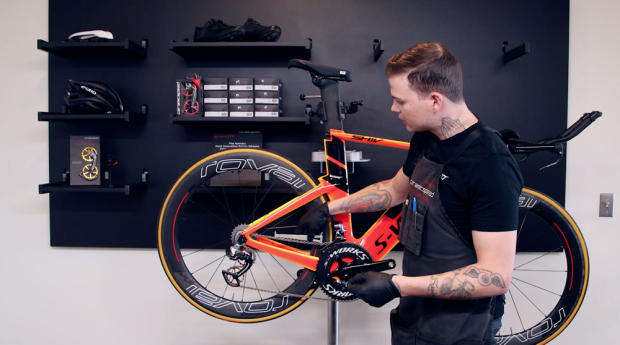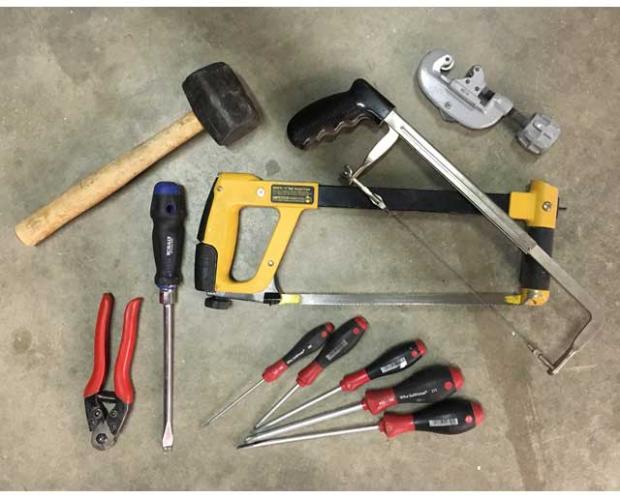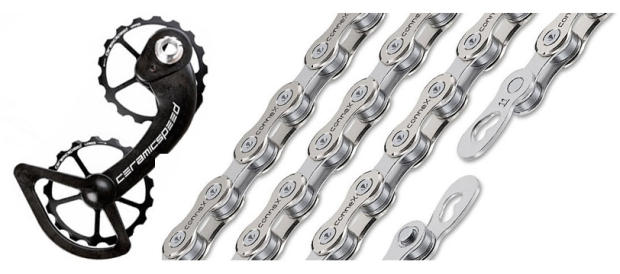Chain Smokin’
Educated (and motivated) consumers have, for many years, developed their own special race-day chain coatings – special processes to strip out-of-the-box chains of their factory lubricants and stuff them with the secret sauce that made the chain as slippery as baby shampoo.
One intrepid consumer eventually formed his own “lab” and essentially made a business out of testing friction levels and selling products of his own design. I myself bought one of Jason Smith’s fast chains for a big race I had in late 2013. I rationalized the chain purchase at the time (which, if I remember correctly, was something around $80–$100) by telling myself that if I had 200 watts to use for the bike course at Cozumel, I wanted to be absolutely positive that every one of those 200 watts was going to effectively move me forward.
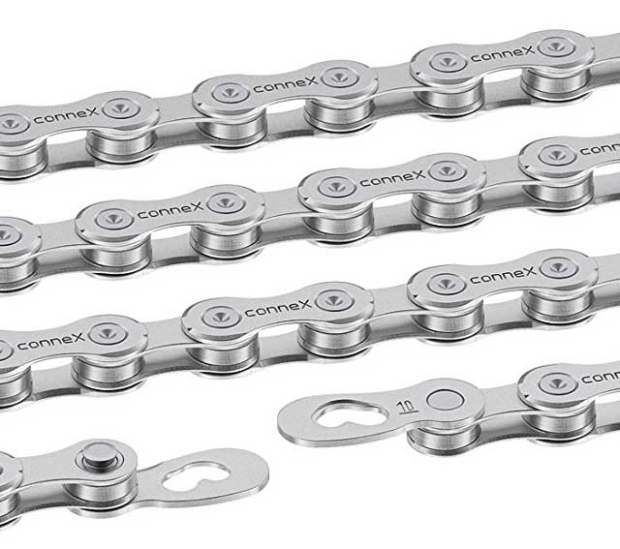
Eventually, in 2016, Jason’s Friction Facts lab was purchased by CeramicSpeed, a company that had – to that point – been on my radar but only subtly. I was “aware” of them in the sense that I knew they made expensive, niche products that involved bearings but beyond that I didn’t concern myself further. This purchase of Friction Facts, however, gave them a few things:
1) Legitimacy – in the eyes of the consumer, Friction Facts was basically the resource for unbiased testing of fairly high–hanging fruit products. Rear derailleur pulley wheels, chains, etc. Having Friction Facts be in–house created a dynamic similar to Specialized’s Win Tunnel in that now with the testing lab working for/with the company itself they could maximize their testing and prototyping process.
2) A very fast chain – the UFO chain (Ultra Fast Optimized) was essentially Jason’s product before Jason’s product became “cool” and a “must have.” Over time CeramicSpeed have increased the lifespan of this coating; I believe when I bought my chain it was ~200km and now that durability has tripled (although the cost of the chain has also gone up by 35–45%).
3) Authority – CeramicSpeed have (presumably purposefully) became the authority in questions of friction and drivetrain “speed.”
They have parlayed those three facets of the acquisition into a massively increased presence in the triathlon world. For the past couple of years we see from them a large booth at the Hawaiian Ironman World Championships. Pros everywhere are outfitted with their UFO chains, OSPW (over sized pulley wheel) system, bottom brackets, wheel bearings, etc. Age groupers willing to drop big money for the highest hanging fruit are similarly equipped.
This burgeoning presence of bicycle “gains” in the drivetrain arena has also spawned similar products from other companies. Recently, a little spat developed between CeramicSpeed and a company called Muc-Off.
Muc-Off began in the early 90s and – these days anyway – is primarily known for being a maker of bicycle products that clean, lubricate, and maintain your bicycle. In fact, if you go to its website, the “shop” tab opens up neatly labeled categories for each facet of your bike’s care. The presentation is (pardon me) clean and polished, and the products are simple.
Where this story really begins, however, is when Muc-Off helped develop the chain and lubrication for Sir Bradley Wiggins’ assault on the hour record. Without going into too much detail, Muc-Off developed a chain that helped propel Sir Wiggins to his hour record on the track and now have created a more “consumer friendly” version that is still basically the same coating but at a lower price. Called the “Nano Chain,” Muc-Off ’s race chain will set you back $199.
However, and perhaps more importantly, if you analyze the marketing material presented by Muc-Off a few claims stand out:
“Our Nanotube Speed Film is an all–weather treatment, so riding in wet or muddy conditions is no problem.”
This undercuts CeramicSpeed’s UFO chain spec list, as the UFO chain buyer is specifically warned against riding in wet or muddy conditions as corrosion will likely result.
“The groundbreaking formula contains Nanotube additives to make it incredibly fast, but still retains the proven all–weather repellency of Muc-Off ’s Hydrodynamic Lube.”
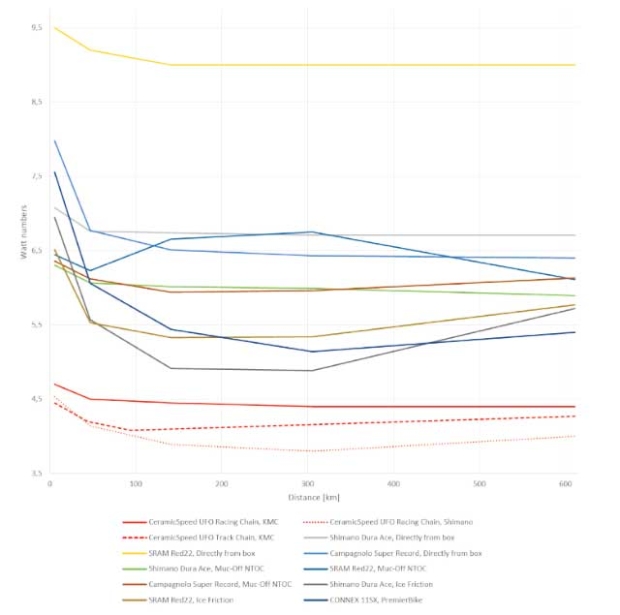
They are really focusing on the “all weather” aspect of the Nano Chain, which reads like a shot at CeramicSpeed. I had to look up what nano tubes are, however, which begs the question: “What is Muc-Off using allotropes of carbon with a cylindrical structure for, anyway?” (Yes, thanks Wikipedia, I’ll donate.)
“Unlike other speed optimized chains where a dry wax is used lasting 200 miles or fewer, the Muc-Off Nanotube Chain Optimisation will benefit you for 400+ miles in dry conditions and 250+ miles in wet and muddy conditions with no severe performance drop off (as happens with dry waxes after a far shorter period).”
Again, a direct shot at CeramicSpeed. The UFO chain, as we mentioned above, lasts well over 200 miles according to the company but, still, Muc-Off is pegging the success of its chain on the all–weather aspects of its durability and watt–savings. Then at the end they casually mention that a “severe performance dropoff” occurs with wax–based coated chains after a “far shorter period” (than what, 250+ miles? A little vague, but my takeaway is that other chains don’t last real good like ours do).
“With power savings of over 10 watts*, Nanotube Speed Film treated chains are delivered to you at their optimum performance level.
*Against CeramicSpeed's Shimano Dura–Ace UFO Chain over a race distance on our dynamometer.”
Just my read, but my impression is that Muc-Off is really going to town against CeramicSpeed. A 10w savings over the – according to Ceramicspeed – fastest race chain you can buy (over a race distance) is pretty big. Is Muc-Off ’s testing misleading? It’s test, on its dynamometer (which we can see vaguely in some pictures is basically a fixed gear drivetrain assembly), says that its chain outperforms the UFO chain by 10w (10w is a LOT in this world, FYI) over a “race distance.” What race distance? Sprint, Olympic, Ultraman, RAAM? You can’t make big, bold statements like that and not expect to get called out for them. Especially if you’re on Slowtwitch…
Enter CeramicSpeed’s Hey, WTF document from October. In summary, CeramicSpeed was upset at Muc-Off ’s testing protocol. They believed that the testing done was both erroneous in methodology and erroneous in terms of the results reported due primarily to that methodological error.
Jason Smith has been perfecting drivetrain friction tests for longer than anyone in the bicycle industry with whom I am familiar. Prior to me reading and studying about these types of tests I was honestly a little in the dark. An example of a question I asked myself: “How can they possibly simulate real world conditions with shifts?” Obviously, Jason is much smarter than I and about a million steps in front; they have devised a method of testing that simulates real world riding (to the degree that a lab test can simulate real world riding) while ALSO having the ability to precisely measure frictional gains and losses. Their two rigs look like a regular bike drivetrain and a fixed gear bike drivetrain. The chain is tested on the fixed gear (this is the only way to precisely measure frictional differences) but “run” on the “regular” drivetrain (CeramicSpeed calls it their Endurance Tester, while the true measurement comes from the Full Tension Tester) which allows for the chain to “slack” while it runs through the pulleys, an extremely important point according to CeramicSpeed.
This “slackness,” in effect, re–lubricates the chain constantly and allows the lubrication to shift and move and penetrate all parts of the inner workings of the chain as it makes its way through the drivetrain. The Full Tension Tester does not allow this, so long term testing on a device such as this will yield results that are inherently wrong and do not represent real world scenarios. So they say!
And it is on this point that Ceramicspeed believes Muc-Off ’s testing went awry. The document goes into great, exhausting detail about how wrong CeramicSpeed believes Muc-Off ’s testing and subsequent results are because of their incorrect methodology.
As a result, says CeramicSpeed, Muc-Off ’s Nano Chain claims are all but hogwash. They also released a new and updated chart showing most of the currently available race chains in their testing’s hierarchy (above).
“CeramicSpeed has a bone to pick with your testing methodology,” we didn’t need to point out to Muc-Off , but did anyway. We wanted to know “what you may want to say about those criticisms.”
“The Nanotube formula we have developed has been designed specifically to provide speed and durability in all weathers,” said Muc-Off ’s Marketing Manager. “Not only are we extremely confident in the science behind the performance of our chain, so are the long list of professional athletes who have won Grand Tours, Olympic medals and set world records whilst riding on a chain using this exact formula.
“Like many industries, we choose to employ the toughest, most repeatable and most accurate tests to prove the performance of our products. When measuring the efficiency of a chain’s performance, we found that our methodology was the clearest way of demonstrating the speed, and critically, the durability under the toughest of loads of our NTC.”
We don’t see an answer to our question in there. There is no refutation of CeramicSpeed’s points, rather a neutral and nonscientific re–recitation of its credo. Still, it’s clear Muc-Off is standing by its testing methodology.
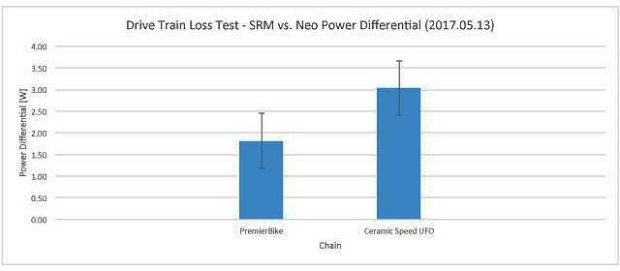
CeramicSpeed is not exactly pure in this. As noted, after CeramicSpeed bought Jason Smith’s products, it bought Jason Smith, right about one year ago exactly. But CeramicSpeed in its messaging, continues has continued to leverage Mr. Smith and his work as if he remains an independent actor, which he is not.
The graph furthest above is what CeramicSpeed says about chains. You essentially have what is – at most – a 3w spread between a stock, out of the box Dura Ace chain and an “optimized” chain.
Just, it’s not always 3w in CeramicSpeed’s favor. PremierBike sent its chain out for independent testing performed by Martin Toft Madsen (MTM on the Slowtwitch Reader Forum), and the graph of that testing is just above. Martin found the Premier chain rather stiff out of the box (Wippermann – that big pic of a chain atop this article is a Wippermann – is the base manufacturer of the Premier optimized chain, and this is how Wippermann makes their chains) and it took several minutes for that chain to loosen up. In Martin’s testing the Premier chain earns a 1.25w benefit over CeramicSpeed’s UFO chain.
Martin’s testing is, by his own admission, "not nearly as granular as some of the bigger test setup of CeramicSpeed or Muc-Off, but there does seem to be repeatability within a watt or two.” Martin has a lot of respect for CeramicSpeed’s testing.
Martin’s, "biggest take-away I've found is that a brand new chain is not the fastest.” He hasn’t tested a worn CeramicSpeed chain yet, though. But perhaps this difference, in when chains are tested – how far along in the life of a chain – helps explain the delta between his testing and CeramicSpeed’s.


